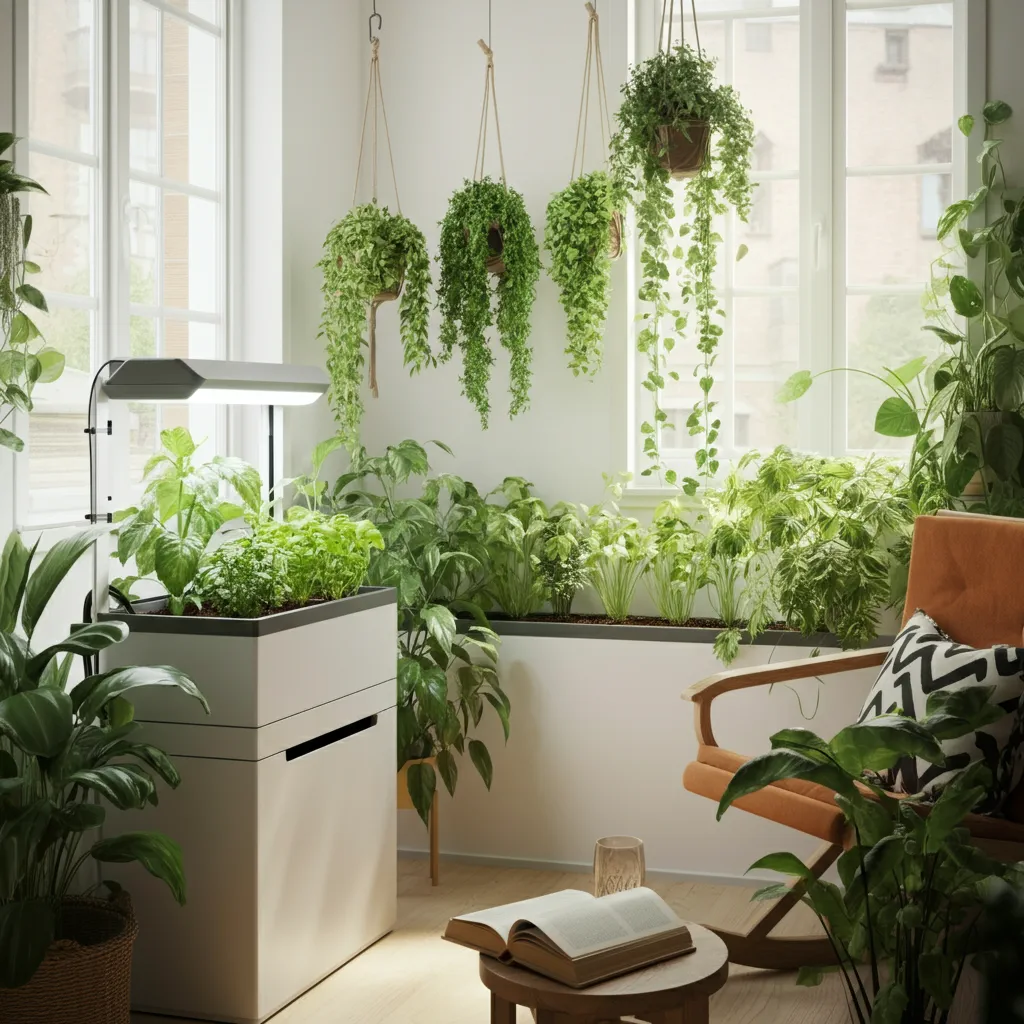
Have you ever dreamed of growing your own crisp lettuce or juicy tomatoes, only to be put off by a lack of garden space or poor soil? What if you could grow vibrant, healthy plants indoors, all year round, without a single speck of dirt? This is the magic of hydroponic gardening, a revolutionary method that's making home-grown produce more accessible than ever.
Hydroponics is a method of growing plants in a water-based, nutrient-rich solution. Instead of their roots digging through soil, plants get everything they need directly from the water. This efficient system allows you to cultivate herbs, vegetables, and even fruits in a controlled environment, free from the usual gardening challenges.
This guide will walk you through everything you need to know to start your own hydroponic garden. We’ll explore its history, the amazing benefits, the different systems you can use, and provide a step-by-step guide to get you growing. Prepare to transform your approach to gardening and enjoy the rewards of fresh, home-grown food.
A Brief History of Growing Without Soil
The idea of soilless gardening isn't as modern as you might think. Its roots stretch back thousands of years to the legendary Hanging Gardens of Babylon, one of the Seven Wonders of the Ancient World. It's believed these magnificent terraced gardens were irrigated by a complex, pulley-driven water system from the Euphrates River—an early form of hydroponics.
The scientific foundation for modern hydroponics was laid in the 19th century. German botanist Julius von Sachs discovered that plants don't actually need soil itself, but rather the essential nutrients found within it. In the 1860s, he developed the first "nutrient solution" formula, proving plants could thrive in water alone.
Fast forward to the 1930s, American scientist W.E. Gericke advanced the practice, demonstrating that hydroponically grown plants absorb nutrients more efficiently, leading to faster growth and bigger yields. Today, from university labs to NASA's space missions, hydroponics is recognised as a highly efficient and sustainable way to grow plants.
The Benefits of a Hydroponic Garden
Switching from traditional soil gardening to hydroponics offers a wealth of advantages for both the gardener and the environment.
- Faster Growth: Hydroponic plants can grow up to 30-50% faster than their soil-grown counterparts. Because nutrients are delivered directly to the roots, the plant expends less energy searching for food and can focus on growing bigger and producing more fruit.
- Space Efficiency: Hydroponic systems, particularly vertical ones, can be set up in small indoor spaces like a kitchen countertop, balcony, or even a cupboard. You can grow more plants in a smaller area compared to a traditional garden.
- Water Conservation: It may seem counterintuitive, but hydroponics uses significantly less water. Compared to traditional agriculture, these systems can use up to 90% less water because it is recirculated and reused, rather than draining away into the soil.
- No Weeds or Pests: Without soil, you eliminate the risk of soil-borne diseases, fungi, and common garden pests. This means you can grow your produce without the need for pesticides or herbicides, resulting in cleaner, healthier crops.
- Year-Round Gardening: Because you control the light, temperature, and nutrients, you are no longer at the mercy of the seasons. You can grow fresh herbs and vegetables all year round, even in the middle of winter.
From the World of Garden Plants Quick Set Up iDOO 12-pod Indoor Hydroponic System - Available on Amazon
How a Hydroponic System Works
All hydroponic systems are built around a few core components that work together to create the perfect growing environment.
Nutrient Solution
This is the lifeblood of your hydroponic garden. Instead of getting nutrients from the soil, plants are fed a special mix of essential minerals dissolved in water. The solution contains major nutrients like nitrogen, phosphorus, and potassium, as well as trace elements like iron and zinc that are vital for healthy growth. You can buy pre-mixed hydroponic fertilisers that make this process simple.
Growing Mediums
Even without soil, plant roots need something to hold onto for support and stability. This is where a growing medium comes in. These are inert materials that don't provide any nutrients but anchor the plant and allow for good aeration. Popular options include:
- Rockwool: Made from spun volcanic rock, Rockwool is a popular choice that holds a lot of water while retaining plenty of air. It often comes in cubes perfect for starting seeds.
- Clay Pebbles (Hydrocorn): These lightweight, porous pebbles provide excellent aeration and drainage. They are reusable and won't affect the pH of your nutrient solution.
- Perlite and Vermiculite: These are often used together. Perlite is a volcanic glass that improves aeration, while vermiculite is a mineral that excels at water retention.
Light and Oxygen
Just like any plant, hydroponic crops need light for photosynthesis. If you don't have a spot with consistent, bright sunlight, you'll need to use artificial grow lights. LED lights are an energy-efficient choice and can be tailored to provide the specific light spectrum plants need.
Roots also need oxygen to thrive. In many systems, an air pump and an air stone (like those used in fish tanks) are used to bubble oxygen through the water reservoir, preventing the roots from suffocating.
pH Monitoring
The pH level of your nutrient solution affects how well plants can absorb nutrients. Most plants in a hydroponic system prefer a pH range between 5.8 and 6.8. You can easily test the pH with a simple kit and adjust it using pH up or down solutions to keep your plants happy.
Types of Hydroponic Systems
There are several methods for setting up a hydroponic garden. While they vary in complexity, they all deliver water and nutrients directly to the roots. Here are three common systems perfect for beginners.
1. The Wick System
This is the simplest and most passive system. It consists of a growing container filled with a medium like perlite or vermiculite, and a separate reservoir for the nutrient solution. A wick, made from a material like felt or cotton rope, runs from the reservoir up to the growing medium, passively drawing the nutrient solution up to the plant's roots. This system is low-cost and easy to set up, making it ideal for herbs and small leafy greens.
2. Deep Water Culture (DWC)
In a DWC system, plants are placed in net pots and suspended directly over a reservoir of oxygenated nutrient solution. The roots are submerged in the water, giving them constant access to nutrients, water, and oxygen. An air pump and air stone are essential for keeping the water oxygenated. This is a very popular method for home growers as it's simple to build and supports the rapid growth of plants like lettuce.
3. Ebb and Flow (Flood and Drain)
This system works by periodically flooding a grow tray with the nutrient solution from a reservoir and then allowing it to drain back out. A submersible pump on a timer controls the flooding cycle. This method ensures the roots get a good dose of nutrients and oxygen as the water level rises and falls. It's a versatile system that works well for a wide variety of plants.
Start Your Hydroponic Journey
Hydroponic gardening opens up a world of possibilities, allowing you to grow fresh, nutritious food in your own home, regardless of space or season. By understanding the basic principles and choosing the right system for your needs, you can enjoy a productive and rewarding gardening experience. Ready to get started? With a small initial investment and a bit of enthusiasm, you'll be harvesting your very own home-grown produce in no time.
The Wick System - Hydroponics
This is the simplest and most passive system. It consists of a growing container filled with a medium like perlite or vermiculite, and a separate reservoir for the nutrient solution.
The Ebb and Flow System - Hydroponics
This system works by periodically flooding a grow tray with the nutrient solution from a reservoir and then allowing it to drain back out. A submersible pump on a timer controls the flooding cycle.
The Deep Water System - Hydroponics
In a DWC system, plants are placed in net pots and suspended directly over a reservoir of oxygenated nutrient solution. The roots are submerged in the water, giving them constant access to nutrients, water, and oxygen.











Community Feedback